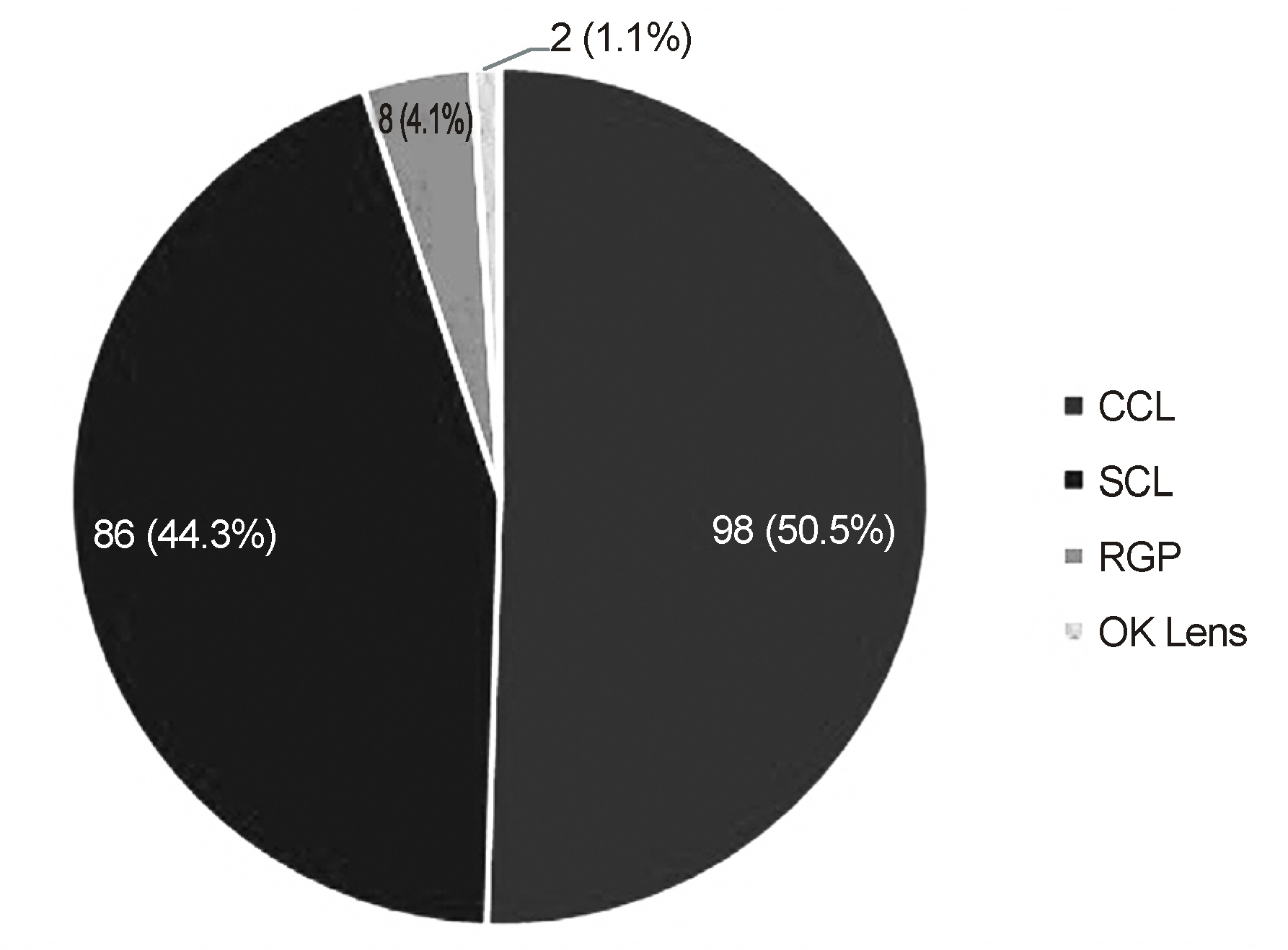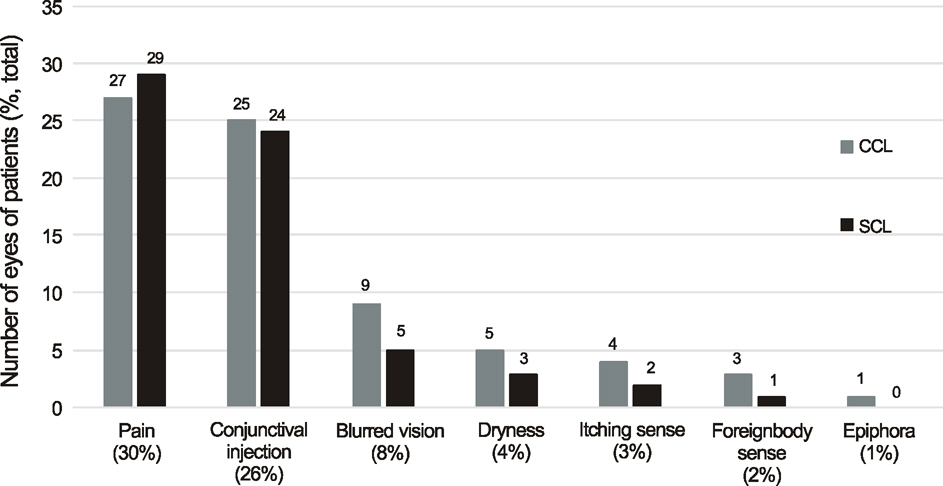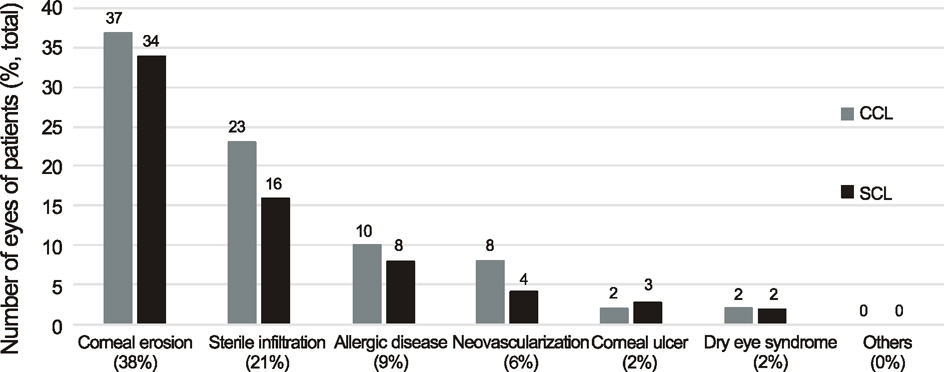J Korean Ophthalmol Soc.
2014 Oct;55(10):1445-1451. 10.3341/jkos.2014.55.10.1445.
Clinical Features and Compliance in Patients with Cosmetic Contact Lens-Related Complications
- Affiliations
-
- 1Department of Ophthalmology, Ilsan Paik Hospital, Inje University College of Medicine, Goyang, Korea. jhk0924@hanmail.net
- KMID: 2216861
- DOI: http://doi.org/10.3341/jkos.2014.55.10.1445
Abstract
- PURPOSE
To investigate the clinical features and compliance of cosmetic contact lens (CL)-related complications compared with soft CL-related complications.
METHODS
We performed a retrospective chart review of 97 patients (194 eyes) regarded as having CL-related complications at the outpatient clinic. The portion of complications, gender, age, and chief complaints at the initial visit were analyzed, as was compliance to cosmetic and soft CL-related guidelines for use.
RESULTS
A total of 97 patients (49 patients with cosmetic CL-related complications and 43 patients with soft CL-related complications) were evaluated. The mean age of the subjects using cosmetic CL was 19.8 years (14-31 years), and all the patients were female. The chief complaints at the initial visit included ocular pain, injection, blurred vision, dryness, itching and foreign body sensation. The main complications included corneal erosion, sterile corneal infiltrate, allergic disease, neovascularization, corneal ulcer and dry eye syndrome. No statistical difference was found regarding chief complaints or complications. The proportion of patients lost to follow-up was 47% in cosmetic CL-related and 20% in soft CL-related complications, a significant difference (p = 0.015).
CONCLUSIONS
Because young females are the most common CL patients and do not always fully comply with the guidelines for use, ophthalmologists need to warn these patients about the risk of serious complications.
MeSH Terms
Figure
Cited by 1 articles
-
The Impact of Written Information on the Compliance with Contact Lens Care
Hee Weon Kim, Sang Yoon Lee, Sang Mok Lee
J Korean Ophthalmol Soc. 2015;56(12):1848-1853. doi: 10.3341/jkos.2015.56.12.1848.
Reference
-
References
1. Kim JH, Song JS, Hyon JY, et al. A survey of contact lens-related complications in Korea: The Korean Contact Lens Study Society. J Korean Ophthalmol Soc. 2014; 55:20–31.
Article2. Rah MJ, Schafer J, Zhang L, et al. A meta-analysis of studies on cosmetically tinted soft contact lenses. Clin Ophthalmol. 2013; 7:2037–42.
Article3. Steinemann TL, Pinninti U, Szczotka LB, et al. Ocular complications associated with the use of cosmetic contact lenses from unlicensed vendors. Eye Contact Lens. 2003; 29:196–200.
Article4. Park SJ, Lee SM, Kim MK, et al. Cosmetic contact lens-related complications: 9 cases. J Korean Ophthalmol Soc. 2009; 50:927–35.
Article5. Lee WJ, Yoon GS, Shyn KH. Corneal complications in contact lens wearer. J Korean Ophthalmol Soc. 1996; 37:225–32.6. Lee JS, Hahn TW, Choi SH, et al. Acanthamoeba keratitis related to cosmetic contact lenses. Clin Experiment Ophthalmol. 2007; 35:775–7.
Article7. Choi TH, Kim HM, Cha HW, et al. Research on the current status of contact lenses in Korea. J Korean Ophthalmol Soc. 2004; 45:1833–41.8. Singh S, Satani D, Patel A, Vhankade R. Colored cosmetic contact lenses: an unsafe trend in the younger generation. Cornea. 2012; 31:777–9.9. Hoddenbach JG, Boekhoorn SS, Wubbels R, et al. Clinical presentation and morbidity of contact lens-associated microbial keratitis: a retrospective study. Graefes Arch Clin Exp Ophthalmol. 2014; 252:299–306.
Article10. Steinemann TL, Fletcher M, Bonny AE, et al. Over-the-counter decorative contact lenses: Cosmetic or Medical Devices? A Case Series. Eye Contact Lens. 2005; 31:194–200.
Article11. Ladage PM, Jester JV, Petroll WM, et al. Role of oxygen in corneal epithelial homeostasis during extended contact lens wear. Eye Contact Lens. 2003; 29:S2–6.
Article12. Song JS, Lee H, Kim JW, et al. The effects of cheap tinted contact lenses on corneal swelling and ocular surface inflammation. J Korean Ophthalmol Soc. 2008; 49:1888–93.
Article13. Sauer A, Bourcier T. Microbial keratitis as a foreseeable complication of cosmetic contact lenses: a prospective study. Acta Ophthalmol. 2011; 89:e439–42.
Article14. Ray M, Lim DK. A rare polymicrobial keratitis involving Chryseobacterium meningosepticum and Delftia acidovorans in a cosmetic contact lens wearer. Eye Contact Lens. 2013; 39:192–3.
Article





